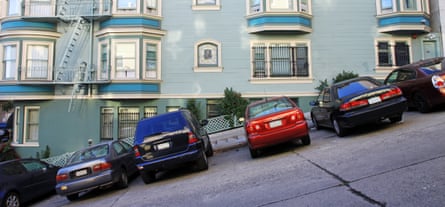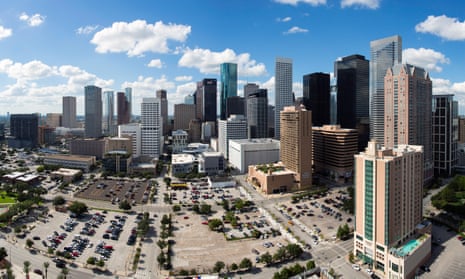With space for roughly 20,000 cars, the parking lot that surrounds the West Edmonton Mall in Alberta, Canada, is recognised as the largest car park in the world.
Spread across vast expanses of asphalt and multi-storey concrete structures, these parking spots take up about half the mall’s 5.2m sq ft, on what was once the edge of the city of Edmonton. A few blocks away, a similar amount of space is taken up by a neighbourhood of nearly 500 homes.
Despite its huge scale, the West Edmonton Mall’s parking lot is not all that different from most car parks around the world. Requiring roughly 200 sq ft per car plus room to maneuvre, they tend to be big, flat and not fully occupied. Often their size eclipses the buildings they serve.
Even when they’re hidden in underground structures or built into skyscrapers, car parks are big and often empty: parking at homes tends to be vacant during the workday, parking at work vacant at night. A 2010 study of Tippecanoe County, Indiana found there was an average of 2.2 parking spaces for each registered car.
The US has long been the world leader in building parking spaces. During the mid 20th century, city zoning codes began to include requirements and quotas for most developments to include parking spaces. The supply skyrocketed. A 2011 study by the University of California, estimated there are upwards of 800m parking spaces in the US, covering about 25,000 square miles of land.
“As parking regulations were put into zoning codes, most of the downtowns in many cities were just completely decimated,” says Michael Kodransky, global research manager for the Institute of Transportation and Development Policy. “What the cities got, in effect, was great parking. But nobody goes to a city because it has great parking.”
Increasingly, cities are rethinking this approach. As cities across the world begin to prioritise walkable urban development and the type of city living that does not require a car for every trip, city officials are beginning to move away from blanket policies of providing abundant parking. Many are adjusting zoning rules that require certain minimum amounts of parking for specific types of development. Others are tweaking prices to discourage driving as a default when other options are available. Some are even actively preventing new parking spaces from being built.

To better understand how much parking they have and how much they can afford to lose, transportation officials in San Francisco in 2010 released the results of what’s believed to be the first citywide census of parking spaces. They counted every publicly accessible parking space in the city, including lots, garages, and free and metered street parking. They found that the city had 441,541 spaces, and more than half of them are free, on-street spaces.
“The hope was that it would show that there’s actually a lot of parking here. We’re devoting a lot of space in San Francisco to parking cars,” says Hank Willson, principal analyst at the San Francisco Municipal Transportation Agency. “And though the perception is always that there’s never enough parking, the reality is different.”
Knowing the parking inventory has made it easier for the city to pursue public space improvements such as adding bike lanes or parklets, using the data to quell inevitable neighbourhood concerns about parking loss. “We can show that removing 20 spaces can just equate to removing 0.1% of the parking spaces within walking distance of a location,” says Steph Nelson of the SFMTA.
The data helps planners to understand when new developments actually need to provide parking spaces and when the available inventory is sufficient. More often, the data shows that the city can’t build its way out of a parking shortage – whether it’s perceived or real – and that the answers lie in alternative transportation options.

With this in mind, the city has implemented the type of dynamic pricing system proposed by Donald Shoup, a distinguished research professor of urban planning at the University of California, Los Angeles. In his book The High Cost of Free Parking, Shoup explains that free or very cheap on-street parking contributes to traffic congestion in a major way. A study of the neighbourhood near UCLA’s campus showed that drivers cruised the area looking for parking for an average of 3.3 minutes. Based on the number of parking spaces there, that adds up to about 950,000 extra miles travelled over the course of a year, burning 47,000 gallons of gasoline and emitting 730 tons of CO2.
After San Francisco implemented a pilot project with real-time data on parking availability and dynamic pricing for spaces, an evaluation found that the amount of time people spent looking for parking fell by 43%. And though there’s no data available on whether that’s meant more people deciding not to drive to San Francisco, various researchers have shown that a 10% increase in the price of parking can reduce demand between 3-10%.
Sometimes, the supply of parking goes down because nobody needs it. Since 1990, the city of Philadelphia has conducted an inventory of parking every five years in the downtown Center City neighbourhood, counting publicly accessible parking spaces and analysing occupancy rates in facilities with 30 or more spaces. Because of plentiful transit options, a walkable environment and a high downtown residential population, Philadelphia is finding that it needs less parking. Between 2010 and 2015, the amount of off-street parking around downtown shrank by about 3,000 spaces, a 7% reduction. Most of that is tied to the replacement of surface lots with new development, according to Mason Austin, a planner at the Philadelphia City Planning Commission and co-author of the most recent parking inventory.

“At the same time, we’re seeing occupancy go down by a very small amount. So what that’s telling us is the demand for this public parking is going down slightly,” Austin says. “And that could be alarming if we were also seeing some decline of economic activity, but actually that’s happening at the same time as we’re seeing employment go up and retail vibrancy go up.”
And though many cities in the US are changing zoning and parking requirements to reduce or even eliminate parking minimums, cities in Europe are taking a more forceful approach. Zurich, has been among the most aggressive. In 1996, the city decreed that there would be no more parking: officials placed a cap on the amount of parking spaces that would exist there, putting in place a trading system by which any developer proposing new parking spaces would be required to remove that many parking spaces from the city’s streets. The result has been that the city’s streets have become even more amenable to walking, cycling and transit use.
Copenhagen has also been reducing the amount of parking in the central city. Pedestrianising shopping streets raising prices of parking and licences and developing underground facilites on the city’s outskirts has seen city-centre parking spaces shrink and the proportion of people driving to work fall from 22% to 16%.
Paris has been even more aggressive. Starting in 2003, the city began eliminating on-street parking and replacing it with underground facilities. Roughly 15,000 surface parking spaces have been eliminated since.
But progress is not limited to Europe. Kodransky says cities all over the world are rethinking their parking policies. São Paulo, for instance, got rid of its minimum parking requirements and implemented a maximum that could be built into specific projects. Beijing, Shenzhen and Guangzhou are hoping to emulate San Francisco’s dynamic pricing approach.
And as cities begin to think more carefully about how parking relates to their urban development, their density and their transit accessibility, it’s likely that parking spaces will continue to decline around the world.
“Ultimately parking needs to be tackled as part of a package of issues,” Kodransky says. “It’s been viewed in this super-narrow way, it’s been an afterthought. But increasingly cities are waking up to the fact that they have this sleeping giant, these land uses that are not being used in the most optimal way.”
Follow Guardian Cities on Twitter and Facebook to join the discussion.

Comments (…)
Sign in or create your Guardian account to join the discussion